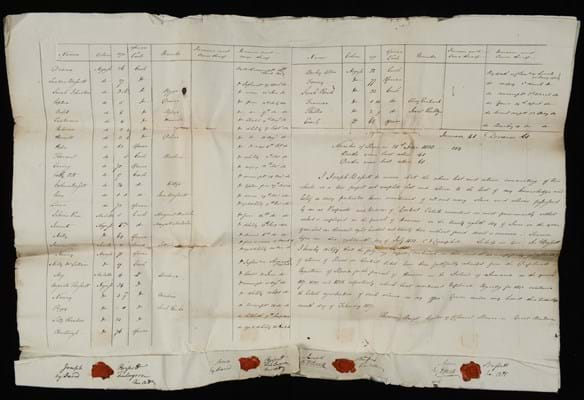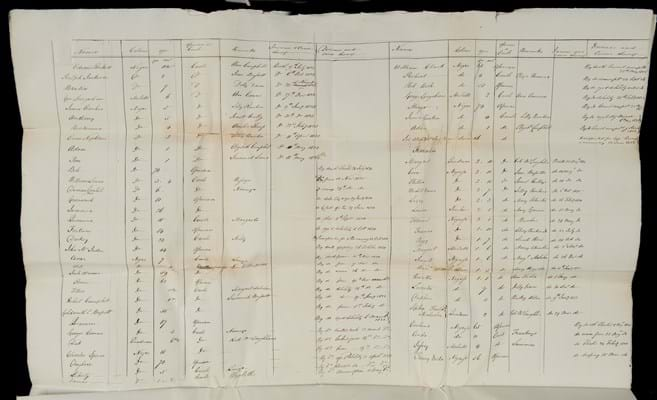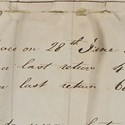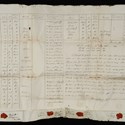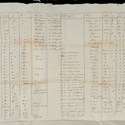The city’s largest concert hall announced last week it will ditch the current name, harking back to the days of slave trader Edward Colston (1636-1721).
Now, a collection of documents has been discovered which underline the source of wealth of another influential Bristolian, and they come up at auction in the West Country on June 2 estimated at £500-700.
Auction house Greenslade Taylor Hunt of Taunton is offering the original slave registrations/returns dating from the early 19th century which have been discovered in Bristol. They record in detail the slaves owned by Philip John Miles (1774-1845), a Bristol merchant venturer and member of parliament, on the Miles family’s sugar plantations in Hanover Parish, County of Cornwall, North West Jamaica, dated 1817, 1820 and 1823 respectively.
In 1807, The Abolition of Slave Trade Act came into force, making the trade in slaves from Africa to the British colonies illegal. To combat illicit transportation following this act many of the British colonies began keeping registers of black slaves who had been so-called ‘lawfully enslaved’.
Twelve years later, the Office for the Registry of Colonial Slaves was established in London and copies of the slave registers kept by the colonies were sent to this office. Registration generally occurred once every three years. The registers continue through to 1834 when slavery was officially abolished.
Family wealth
The Miles family’s wealth was first created by William Miles (1728-1803) who moved to Bristol from Herefordshire in his teens and became engaged in the sugar industry. He managed a sugar plantation in Jamaica and was later a sugar merchant at home in Bristol. He owned a refinery, the Sugar House (now Hotel du Vin in Lewin’s Mead), and further developed his business interests in shipping in the West India Trade.
Philip John Miles inherited the family wealth and diversified into banking as well as sugar and shipping. In 1811, he bought the Abbots Leigh Estate, but in the same year his first wife Maria died, and Miles delayed commissioning the new mansion of Leigh Court until 1814. Miles remarried in 1813 – to the wealthy Camilla Peach by whom he had 11 more children - and during the three years of construction he lived at Naish House in Portishead. In 1832, helped by compensation for the loss of 2200 slaves following abolition, he bought King’s Weston House in Bristol and used it as his main residence.
He died in March 1845, leaving in his will £1m.
Specialist Malcolm Claridge says: “The importance of the hand-written documents is beyond doubt, but make very uneasy reading indeed. There, written in neat headed columns, are names of men, women and children, all forgotten faces of the past, many of them taken from their homes in Africa, and sold into slavery at the ports of Jamaica.
"Their sex, their colour, their age (eight days to 76 years), their creed, African or Creole (born in Jamaica), are all recorded. More poignantly a column headed ‘Cause of Death’, draws the eye: ‘Worms’ – ‘Fever’ – ‘Drowning’ – ‘Consumption’ – ‘Child Birth’ and perhaps most ironic ‘By Death’. Other facts, recorded under the heading of ‘Remarks’, contain ‘Runaway’.”
Claridge adds: "The documents turned up in a pile of papers from a deceased estate in Bristol. I was contacted to look at some militaria-related things, but came across these documents while browsing, I did a little research and realised what they were."
The anonymous vendor is from Bristol and will be donating some of the proceeds to a "relevant charity".
Abolition of slavery
In 1823, the British Government pledged to adopt measures for the abolition of slavery in the colonies. Almost 11 years later, in 1834, after long drawn-out exchanges of letters between the planters and legislatures, and during which time Jamaica experienced several rebellions of agitated slaves in Hanover, and the surrounding areas, the bill was conditionally passed. Finally, four years after that, on August 1, 1838, the slaves received their unrestricted freedom.
A census conducted of Hanover in 1824 revealed that there were 502 whites, 1438 free coloureds and 22,945 slaves.



